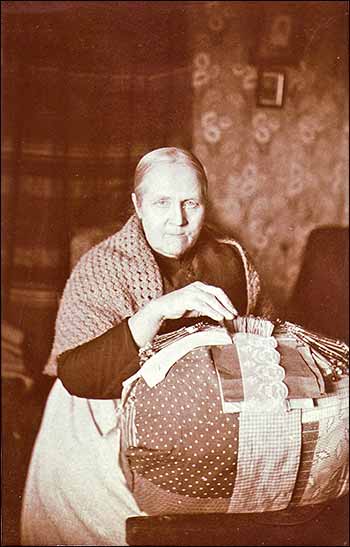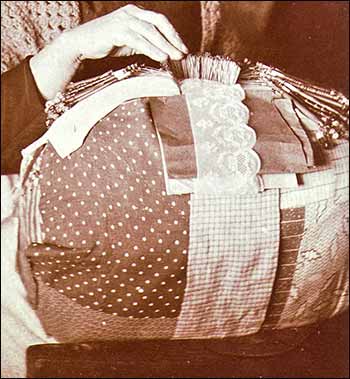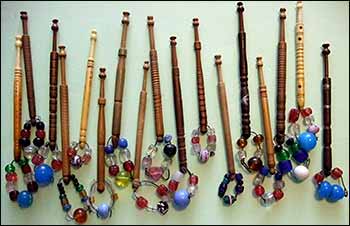More are Turning to Craft of Lacemaking
THE Intricate craft of pillow lace making, which many of the present generation thought to have died out with their grandmothers' day, has seen a definite revival locally. Older women are turning out their long-stored pillows and bobbins and many younger women, too, are beginning to learn the work.
One such, is Mrs. Doreen Perkins, of 90, High Street, Rushden. Her contribution of pillow lace, on which she works every evening, was one of the most admired features at the Rushden Rotary Club's exhibition of hobbies. Tea-cloths, handkerchief squares, collars and cuffs, and doylys are just a few of the exquisite products at her command. Mrs Perkins told us that her interest in pillow-lace making originated in the '30s and she sought the guidance of two of the town's old Craftswomen in this art—Mrs. Elliott, of Wellingborough Road, and Mrs. Wilding, of Grove Street.
Afterwards, whenever she heard of an old lady in one of the outlying villages who might be able to teach her "a new stitch" she would visit her and acquire a little more knowledge. To-day she herself is teaching pupils. Her pillows and her bobbins have all been acquired from interested friends and customers at her shop.
Few people, however, realise what an important influence pillow lace making had on the lives of Northamptonshire people in days gone by and to what a large extent it flourished in Northants, Beds and Bucks.
Pillow lace originated in this country at the time when thousands of Protestants fled to England from, the Low Countries to escape Inquisition, and the famous Mechlin lacemakers from Flanders settled at Cranfield, Bedfordshire, in 1568. The "industry" soon established itself in the three counties and men, women and children all made point lace. By the 18th and 19th centuries children, boys included, were being taught lacemaking at ''lace schools" which were held in the room of a cottage in nearly every village.
|
 |
Hard Lot in Winter
In summer all would go well, but in winter their lot was a hard one. In Normandy the lace makers had overcome the danger of their work being darkened by smoke and dust from a fire by working over a cowshed.
Locally they overcame this difficulty by the introduction of the somewhat pleasanter method of a fire pot or a dicky pot—a pot made of rough brown ware and filled at the nearest baker's every morning with hot wood ashes at a cost of a farthing.
These were not only used during the 12-hour working day at the lace schools, but by the older girls and women in their own homes
Together with "flasks" containing "show water", which focused the light from a candle on to the pillows after the style of a burning glass; they became indispensable.
Lace for Coronation
At Olney, even to-day, if one is seen looking "browned off," the greeting may still be "You look as if you've been sitting over a dicky pot all day."
|
Above: Jane Morris of Shelton with her lace pillow
Below: the lace & pillow
|
 |
At Shelton, Beds, lace for the coronation of the Dowager Queen Mary was made by the late Miss Jane Morris.
Bobbins invariably commemorated christenings, marriages and deaths with either names or suitable inscriptions. Often they would be made from the bone of a ham or other joint at the appropriate feast.
Hangings were another popular source of souvenir bobbins: the lace schools would close down to allow the pupils to watch the ceremony and afterwards the youngsters would have an appropriate bobbin carved out. Suicides and elections were other occasions for a new bobbin.
|
|
Grim Reminder
Mrs. Perkins has one engraved, "William Worsley, hung 1868". Worsley's execution On March 31st of that1 year was the last public hanging in Bedford.She has others engraved with the names Mary Ann Cooper and John Cooper, of Irchester, 1871, together with sentimental bobbins—"Love, give me thy heart"; "Buy the ring"; "I'll vow to be true"; "O my love is absent"; and "I would not live always".
The colourful "spangles" which hang from the bobbins are there for purely practical reasons only: they weight down the bobbin as it hangs from the pillow.
|
|
The Great Holidays
The great holiday of the lacemakers was "Tanders" (St. Andrew's Day, November 30th), but in some parts of Northants, Beds and Bucks the leading festival was Catterns (St. Catherine's Day, Nov. 25th), St. Catherine being the patron saint of the spinners, to whom the lace makers considered themselves related. As early as 1672 it was the custom to give the inmates of the workhouse at Aylesbury sums of money to keep Catterns Day.
At Peterborough a number of the girls, attired in white decorated with scarlet ribbons and headed by the prettiest of their number, who wore a crown and carried a sceptre, went around the city singing a ballad.
At Kettering Cattern cakes, made of dough and caraway seeds, were distributed and the evening was spent in singing, dancing and feasting, the principal dish being stuffed boiled rabbit.
Below: some of Jane's bobbins
|
 |
Festivities
At Podington they kept Catterns by "wetting the candle-block", that is, taking tea together and eating Cattern cakes. After dancing to the music of a fiddle, they concluded the evening by supping on a great apple pie.
At Spratton the children of the lace school used to lock their mistress out of the room. After a brief display of mock anger, the mistress would yield to their demands for a holiday.
|
|
At Bozeat the church bells were rung at noon and everywhere fiddles struck up, and ballads were sung.
May Day was also kept as a holiday by the lacemakers in some villages. At Mears Ashby, for example, it was a great holiday, and the children would carry a branch of may on which there were dolls dressed in lace.
In all the lace-making villages every five weeks there was a "cut-off" day when the lace was removed from the pillows and carried to the lace buyer or his agent, who generally met the workers at the village inn.
Their painstaking work would then be rewarded with a few coppers or groceries given in exchange. To-day it can command pounds.
|
|
|
Notes: Bedfordshire lace bobbins most often had square beads amongst the spangles. Bobbins were made from wood or bone, some had silver or pewter inserts. Many had names or commemorated events. They may have been made a sweetheart. Amongst Jane's there are three of bone, (1, 5 & 16 in the row), one is marked "Dear William", and another "Forget Me Not". Shelton is only five miles from Rushden, close to Hargrave and Yelden, and is on the county boundary. The photographs and bobbins have been given to Rushden Museum by Jane's great nephew, Mr Dickerson.
|


